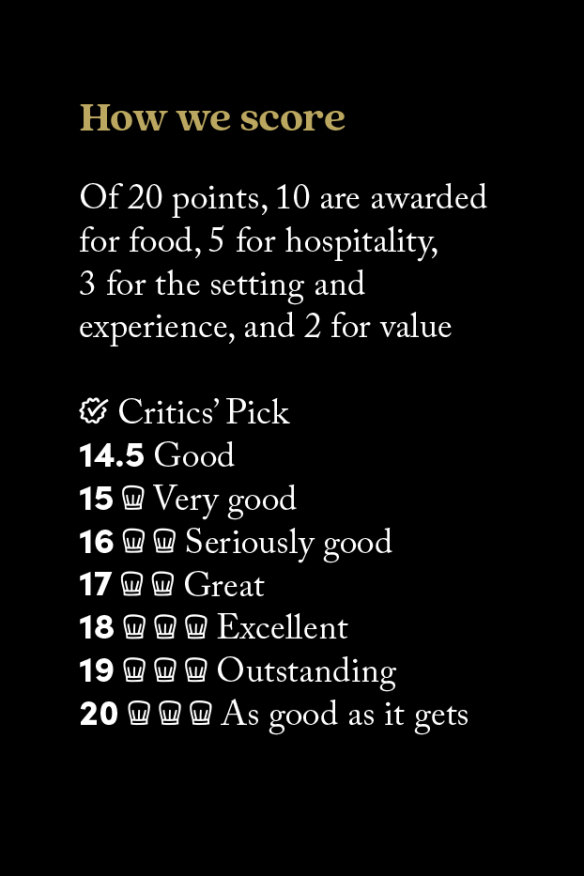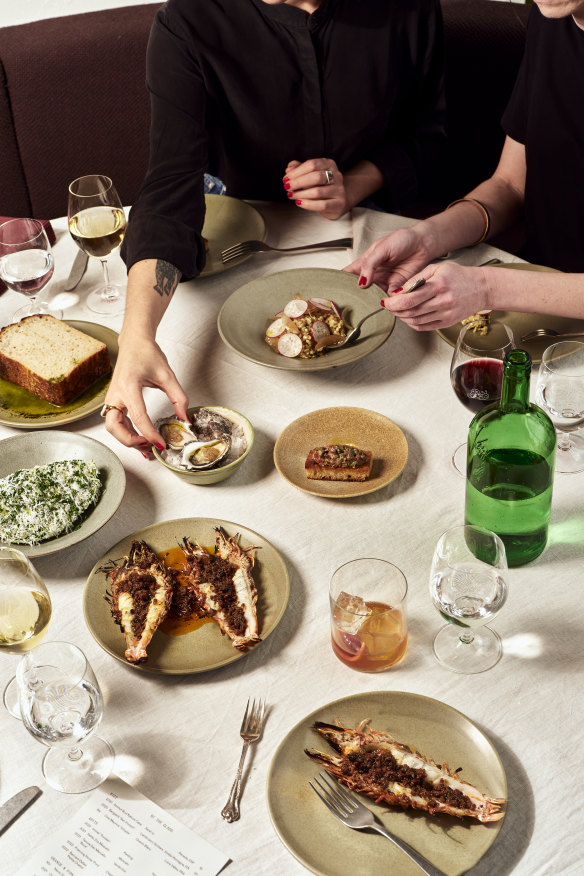
From if restaurants can pay to be included (no), to how the hat scoring works, here’s everything you need to know about the annual dining bible.
What is the Good Food Guide?
For more than 40 years, the Good Food Guide has been the unrivalled annual dining guide, designed to inform the public about Australia’s best restaurants, bars, pubs and cafes.
Published by The Age and Sydney Morning Herald each year, it is a collection of reviews across various price points, cuisines, styles and suburbs, offering an annual snapshot of the most exciting, outstanding venues you need to know about.
Our main goal isn’t to tell you whether we like a restaurant. It’s to paint a picture of the experience so you can decide whether you might like it, and to explain how it sits within Australia’s dining landscape. With money tighter than ever for most diners, users of the guide want to know where they should spend their money, and be able to trust those recommendations.
Our main goal isn’t to tell you whether we like a restaurant. It’s to paint a picture of the experience so you can decide whether you might like it.
Who is behind the Good Food Guide?
The Guide is produced by The Sydney Morning Herald and The Age, owned by Nine Publishing. Its editors are bound by the Nine Publishing Charter of Editorial Independence, whose first point states: “Nine publicly declare a commitment to the fundamental and longstanding principle of editorial independence.”
The two annual editions are the work of a team that includes editors, senior food critics and a diverse group of freelance reviewers in each state. For the 2025 Guide, our national reviewing team is made up of more than 88 people of varying ages, cultural backgrounds and life experiences. In each state, a senior panel of critics and editors with many decades of combined experience finalises scores, hats and awards.

How do Good Food Guide reviews differ from others?
Every venue in the Good Food Guide has been reviewed by one of our team in the past 12 months. We visit many others that don’t make the cut.
We’re often asked if we tell restaurant owners when we’re coming in, if we get free meals or if we get paid by the venues we review. We don’t. Just as we have done for more than 40 years, reviewers book under a pseudonym and pay their bill like everyone else.
Every venue is scored according to a strict set of criteria (see below), and every score is discussed by a panel of senior reviewers.
Can restaurants pay for inclusion in the Guide?
No restaurant can pay to be included in the Good Food Guide. In fact, The Age and Sydney Morning Herald spend hundreds of thousands of dollars in Australian restaurants each year to put the Guide together.
The SMH and Age Good Food Guides should not be confused with the Australian Good Food Guide, a completely separate organisation that asks restaurants for payment to be featured recommendations.
Do sponsors and commercial partners influence the Guide?
Sponsors and commercial partners have no influence over which restaurants are included in the Guide, and are in no way involved in the selection, scoring or awards process.
Home of the hats
Heard the expression, “It’s a hatted restaurant”? The chefs’ hat rating system was created by the Good Food Guide more than 40 years ago to give readers a sense of what to expect in terms of food, service and experience. It has been the cornerstone of our rating system ever since.
How the hats work
Each restaurant reviewed in the Guide is scored out of 20: 10 points for food, five for hospitality, three for setting and experience, and two for value.
Our reviewers are guided by what the venue sets out to achieve when determining scores. Not all restaurants that have the same score will necessarily look and feel the same. It’s more about whether the venue is succeeding in being the best version of itself.
Restaurants scoring 15 or above are awarded one hat, those scoring 16 or 17 receive two hats, and those between 18 and 20 receive three hats. Those scoring 14 or below will be included in the Guide if the reviewer or senior panel awards them a Critics’ Pick tick.

What’s a Critics’ Pick?
Because the definition of an enjoyable dining experience is broader than it’s ever been, in 2023 we introduced the Critics’ Pick, marked by a tick symbol.
These venues may not fit comfortably into the traditional scoring system, particularly in the areas of setting and service, scoring below 14, but are some of the most exciting places to eat. They contribute in a meaningful way to the city’s food culture and are worth celebrating.
A restaurant may be a reliable suburban bistro beloved by locals, but to be awarded a Critics’ Pick tick, it needs to stand out from the pack by satisfying the following points by being:
- somewhere you would cross town to visit,
- among the best in its style of cuisine and offering,
- somewhere you would recommend to friends,
- a place that adds something special to the city’s dining culture and conversation.
How often do you review venues?
Every year we head into venues across Victoria and NSW to assess whether they’re up to scratch. We write a fresh review and score based on this visit.
Some venues are visited multiple times if there is a discrepancy in reviewers’ scores or if major changes have taken place between visits. In particular, decisions over whether a venue goes from two hats to three or three to two, will involve multiple visits by senior reviewers.
How do you choose which restaurants are reviewed?
Any restaurant that scored 14.5 or more in the previous edition is reviewed and reassessed. A new venue is considered if it looks interesting and exciting, or if there’s proven talent at the helm. An older establishment may be featured for the first time if a reviewer (or perhaps a reader) recommends it for doing something that sets it apart from others of its kind in the area.

If a restaurant is reviewed by Good Food during the year, will it automatically get the same score in the Guide?
Not necessarily. Every year we re-review every restaurant listed in the Guide. Because of this, a restaurant visited by our sister publication Good Food shortly after it opened may score, say, 16/20. But it may receive a different score in the Good Food Guide after having been revisited months later.
Do you ever wear disguises?
Not usually. But the occasional baseball cap and pair of chemist-bought glasses have foiled even the most eagle-eyed maitre d’.
The fact-checking process
Reviewers are required to provide details about every dish they ate, and to check with the venue if they’re unsure about the veracity of any of the claims in the write-up. Often, if something seems awry, our editors or subeditors will follow up, either by email or phone, for a line-by-line check of the review. Asking obvious and sometimes tedious questions is part and parcel of good fact-checking and journalism.
How are any conflicts of interest handled?
Reviewers are required to declare any conflicts of interest to their editors upon receiving a commission. If a reviewer has any conflict of interest, they won’t be assigned the review and it will be allocated to someone else.
Our reviewers work in a range of fields, and many of them are freelancers. Conflicts of interest – former or current professional relationships, personal relationships – are inevitable. This is why we require reviewers to declare them up front, and reassign reviews where a conflict exists.
Some examples might include where a reviewer engages in copywriting for a restaurant group, co-writes, ghost-writes or edits a book by a chef, is close friends with a restaurant owner or chef, or has previously worked for them or alongside them. In all cases, the review would be reassigned to someone else. In the case of editors and discussions over scores or hats, they’ll defer to the other senior panel members where any conflicts may exist.
Apart from being professional writers, our reviewers are professional eaters.
Do you need a culinary (or any) qualification to be a reviewer?
It can help, but the thing we require most from our reviewers is that they represent the public. We expect reviewers to have a certain level of interest and expertise in food and drink, but their role, above all, is to represent the diner, to convey to them what it’s like to go to a venue and eat and drink there, and whether it’s worth their time and money.
In one sense, apart from being professional writers, our reviewers are professional eaters, with years – often decades – of accumulated experience interrogating food and restaurants behind them.

It must be nice to be paid to eat free meals
It’s true that Good Food covers the bill, but contrary to popular belief, our reviewers are paid nothing for eating a meal. They’re paid for writing the reviews. Rates are industry standard, and there are guidelines on how much food and drink reviewers can expense.
Given the time, expertise and labour that goes into visiting venues and writing the reviews and notes, filing receipts and invoicing, many reviewers are doing it simply because they’re passionate about the industry, and are dedicated to celebrating it.
How is Good Food tackling allegations of misconduct in hospitality?
The inclusion of venues in the Guide is at the editors’ discretion.
If a venue is known to allow criminal offences, particularly of a violent or sexual nature, they exclude themselves from being included in the Good Food Guide. We can’t, in good conscience, recommend venues that are known to allow or perpetrate abuse, especially when it rises to the level of criminal abuse.
This position represents the biggest evolution to the Good Food Guide’s approach to reviews in its four-decade history, and widens the criteria we may use to decide which restaurants, bars and cafes we recommend. The Good Food Guide is still about where our editors recommend you eat, but in 2024 we believe diners also care about ethics.
Why are there venues in the Guide where people say offences have taken place?
Investigating hospitality workplaces is far from easy. We can’t rely on rumour or gut feeling, or exclude venues and people for behaviours we find objectionable. It requires the highest standards of reporting, and not all investigations are published. At times, we may investigate allegations but be unable to substantiate the claims.
You may know something, but we may not. To report an instance of unethical behaviour in the hospitality industry, use this form so we can follow it up. This is the first step in a long road, and it will take time to investigate every tip we receive.
If a venue is dropped from the Guide, does that mean allegations have been made against them? Or that allegations have been substantiated?
No. Venues are excluded for many reasons including:
- A drop in score due to the quality of the food, service and/or setting
- Not satisfying the criteria for either a hat or a Critics’ Pick tick
- Not representing the best or most exciting dining of the moment
How does an organisation that has previously had an unacceptable culture become eligible again?
The Good Food Guide is an annual publication and inclusion is at the discretion of the editors. If we are satisfied that enough new and far-reaching and transformative policies and procedures have been put in place, and real relevant changes have been made, the editors will consider reinstatement to the Guide.
The winners of The Sydney Morning Herald Good Food Guide 2025 Awards will be announced on November 11, presented by Vittoria Coffee and Oceania Cruises. The Sydney Morning Herald Good Food Guide 2025 will be on sale from November 12.
The winners of The Age Good Food Guide 2025 Awards will be announced on November 18, presented by Vittoria Coffee and Oceania Cruises. The Age Good Food Guide 2025 will be on sale from November 19.
Restaurant reviews, news and the hottest openings served to your inbox.
Sign up


























